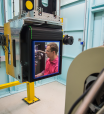

Showing 781 - 800 of 1472 results


Role at ANSTO
Certificate of appreciation from WA DFES
ANSTO and the Australian Radiation Protection and Nuclear Safety Agency (ARPANSA) have been recognised for their valuable contributions to the search and recovery efforts for a missing 8mm-long radioactive capsule in the Western Australian outback.
Pan-Asian Neutron Scattering Conference in Sydney

Technical Information - Joey
Specifications and Sample environments
Miriad profile - nandin member
Hear from our most recent addition to the nandin Innovation Centre, Tomonori Hu, Founder and CEO of Miriad.
Fission vs fusion: an explainer
The release of the Oppenheimer film, the story of the director of the Manhattan Project, has prompted many people to go online and search for an explanation of the difference between fission and fusion, two fundamental scientific concepts.
Neutron scattering scientists recognised by their peers
Action plan to fight CKDu
Australia and Sri Lanka develop action plan to fight Chronic Kidney Disease killer
ANSTO plastic trawling from Hobart to Sydney

High Performance Macromolecular Crystallography Beamline (MX3)
The High Performance Macromolecular Crystallography beamline will enable the study of very small (sub-5 micrometre) or weakly diffracting crystals, providing a state-of-the-art high-throughput facility for researchers. MX3 will be able to study the structures of large proteins and protein complexes for virology, drug design and industrial applications via goniometer mounted crystals, in-tray screening, or via serial crystallography methods.

Shenal Basnayake is CEO of the Australian Science Teachers Association and is responsible for leading a team of dedicated professionals committed to promoting the profession of school science education and enriching science teaching.

Role at ANSTO
Dr Joseph Bevitt is a senior instrument scientist on the Dingo radiograph/tomography/imaging station, and scientific coordinator for the Australian Centre for Neutron Scattering.
Giant clams open up climate secrets
Superconductivity Research from ECHIDNA in this week's Nature Materials
2025 Federal Election: Caretaker Arrangement

National Deuteration Facility
The National Deuteration Facility offers the facilities and expertise to produce molecules where all or part of the molecular hydrogen is replaced with deuterium. This enables complex investigations of the relationship between the structure of molecules and their function using neutron scattering and other techniques.

Helen's research interests focus on determining the thermoelastic properties and crystal chemistry of a range of minerals which are of interest in a variety of environmental, planetary geology and industrial settings.
University appointment
Dr Anna Paradowska has been appointed as a Conjoint Professor of Practice in Advanced Structural Materials at the University of Sydney.